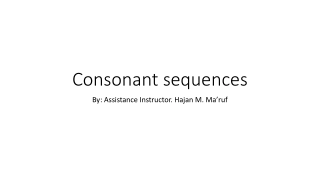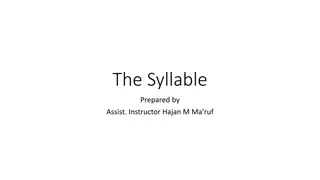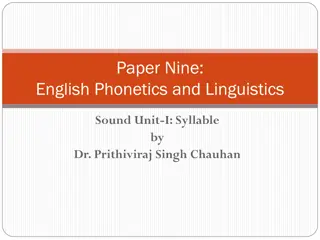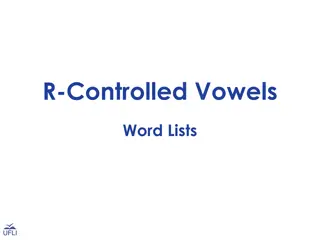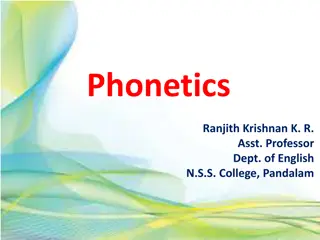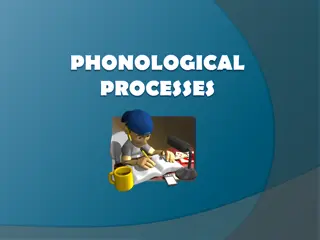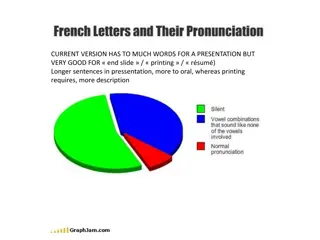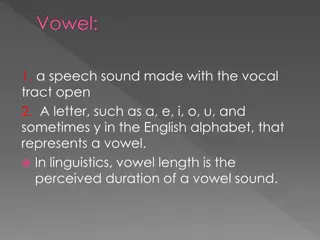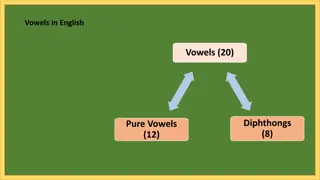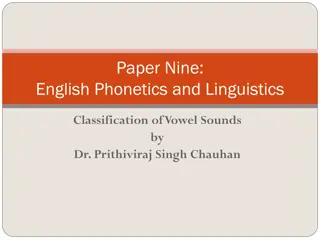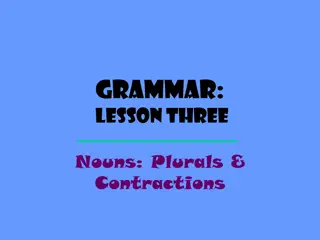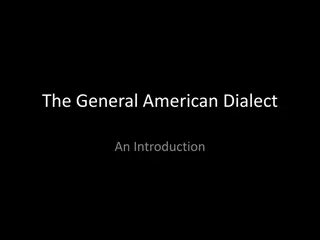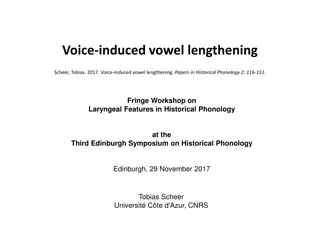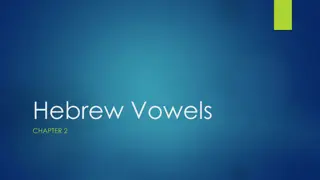Understanding Vowels and Consonants in English Language
The English alphabet consists of 26 letters, with 5 vowels (A, E, I, O, U) and 21 consonants. Vowels are unique sounds produced by opening the mouth without obstructions, while consonants involve partial or complete closure of airflow. Vowels can be further categorized into long and short based on their duration. The classification of vowels considers factors like tongue position, lip shape, and vowel length. Understanding these distinctions aids in pronunciation and language clarity.
Download Presentation

Please find below an Image/Link to download the presentation.
The content on the website is provided AS IS for your information and personal use only. It may not be sold, licensed, or shared on other websites without obtaining consent from the author. Download presentation by click this link. If you encounter any issues during the download, it is possible that the publisher has removed the file from their server.
E N D
Presentation Transcript
Vowels and consonants ASSIST. INSTRUCTOR HAJAN MUHAMAD MARUF
Vowels and consonants The English alphabet has 26 letters (5 vowels and 21 consonants), but 44 sounds (phonemes). The 44 English sounds can be divided into two major categories consonants and vowels. A consonant sound is one in which the air flow is cut off, either partially or completely, when the sound is produced. In contrast, a vowel sound is one in which the air flow is unobstructed when the sound is made. The vowel sounds are the music, or movement, of our language.
What is a Vowel? First things first: what's a vowel? There are 26 letters in the English alphabet, but there are only five vowels: A, E, I, O, and U. What about vowels makes them so special? Of the 26 letters, A, E, I, O, and U are the only ones that represent sounds you can make just by using your voice and opening your mouth. Try saying the letter A, but hold the sound for five seconds. Notice how your mouth does not need to move to say it out loud. You can do the same thing for the letters E, I, O, and U.
Long versus Short Vowels According to their length English vowels are subdivided into long and short. Look at the words 'bug' and 'bugle.' How are they similar? How are they different? The words are similar because they both include the letters B, U, and G. The way the U sounds in each word is different. Why is this the case? Vowels can be used in words to make more than one sound. These sounds are described as 'long' and 'short.
All vowels are classified according to the following principles Position of the tongue Shape of the lip Length of vowels
Classification of vowels Three major factors in the production of vowels are the openness, or height, of the mouth, the position of the tongue, and the roundness of the lips. If a vowel is produced while the mouth is almost closed, it would be considered a close If the vowel is slightly more open, it would be considered a mid vowel. And if the mouth is open very tall, it would be considered an open vowel. If the tongue is positioned near the front of the mouth, any vowel produced would be a front If the tongue were set slightly more back in the mouth, the vowel would be a central vowel. If the tongue were set in the far back of the mouth, the vowel would be a back vowel. If a vowel is produced while the lips are tense and rounded, it would be considered a rounded. If the vowel is produced while the lips are relaxed, it would be considered an unrounded vowel.
Long vowel A long vowel letter A. A 'long E' sounds like the letter E. So when does a vowel make a 'long vowel' sound? This usually happens one of two ways: sounds like the name of the letter. For example, a 'long A' sounds like the 1. The first way to make a long vowel sound is to put two vowels next to each other. When two vowels appear next to each other, the word usually makes a long sound of the first vowel. This is the case in words like 'bead,' 'seed,' 'mail,' and 'boat.' Notice how the word 'bead' makes the long E sound and the word 'mail' makes the long A sound. 2. The second way to make a long vowel sound is to place an E at the end of a word. Placing an E at the end of a word also creates a long vowel sound. This happens in words like 'bake,' 'bike,' 'mote,' 'mute.' Notice how the word 'mute' makes the long 'U' sound and the word 'bike' makes the long 'I' sound.
Short Vowels In many words, vowels do not make a long sound. They make a short vowel sound instead. How can you tell the difference? Finding short vowels is actually pretty easy: if it doesn't sound like any of the vowel letters, then you know it's a short vowel! Short vowels usually sound like the following: A = 'ah' as in 'apple' E = 'eh' as in 'egg' I = 'ih' as in 'insect' O = 'awe' as in 'bog' U = 'uh' as in 'tug' Let's take another look at our example words from before: 'bug' and 'bugle.' Notice how the word 'bug' does not have the long U sound that the word 'bugle' does. The word 'bug' has a short vowel sound.
Front and back vowels The vowels are differ from each other. The first matter to consider is the shape and position of the tongue. It is usual to simplify the very complex possibilities by describing just two things: firstly, the vertical distance between the upper surface of the tongue and the palate, and secondly the part of the tongue, between front and back, which is raised highest. 1. back vowels :/u:/and /a:/ you tilt your head back when you articulate them. 2. front vowels : /a/ and /i:/ when you articulate them, you feel that the front part of the tongue is raised. Shape of the lips: 1. Rounded, where the corners of the lips are brought towards each other and the lips are pushed forward. E.g. /u/ 2. Spread, with the corners of the lips moved away from each other, as for a smile. E.g. /i/ 3. Neutral, where the lips are not noticeably rounded or spread. E.g. The noise er for hesitating
Consonant sounds English has 24 consonant sounds. Some consonants have voice (cause vibration in the vocal cord) and some don t. These consonants are voiced and voiceless pairs /p/ /b/, /t/ /d/, /k/ /g/, /f/ /v/, /s/ /z/, / / / /, / / / /, / / /d /. These consonants are voiced /h/, /w/, /n/, /m/, /r/, /j/, / /, /l/. The only English glottal /h/ sound forms in the glottis with a slight friction noise, the vocal cords don t vibrate, speech organs in super glottal cavities shape to pronounce a vowel after the glottal consonant. E.g heat, hot, heart. Glottis is the opening into the windpipe, which is responsible for the production of sound. Epiglottis is the cartilaginous flap on top of the glottis, which prevents the entering of food into the larynx
Classification of consonants 1. Place of articulation 2. Manner of articulation 3. voicing
Place of articulations Nasal consonants are sounds made when the air flow passes through nasal cavity rather than the oral cavity, as a result of lowering the palate. (m and n). / / This sound does not occur at the beginning of words in English. Velar consonants are made when the tongue is in contact with lower side of velum. (k and g) Labial: are sounds in which the lips are in contact with each other. (p and b) Labiodental: are sounds in which the lips are in contact with teeth. (f and v) Dental sounds made with the tongue touching the upper front teeth. ( and ) Alveolar sounds made with the tongue touching alveolar ridge (t and d) Glottal consonant is articulated with the vocal cords (h). For like glottal stop /?/ Palatal articulated with the front of the tongue against or approximated to the hard palate (sh and zh)
Manner of Articulation 1. Stop: a consonant sound where the airflow is stopped completely by the mouth and then sharply released. Think of sounds like /p/, /k/, and /t/ . All languages contain stops. 2. Fricative: a consonant sound where the airflow becomes noisy and turbulent because it only has a very small space to travel through in the mouth. Think of sounds like /f/, /s/, and / /. Most languages have fricatives, but not all. 3. Nasal: a consonant sound where the airflow passes exclusively through the nose instead of the mouth. Think of sounds like /m/, /n/ or / /. Almost all languages have nasals. 4. Affricate: a consonant sound that begins like a stop but then releases like a fricative, thus making it a sort of combination sound. Think of sounds like /t / and /d / . Affricates are common, especially in English.
5. Approximant: Here the airflow is impeded only slightly. The hissing sound indicative of fricatives is no longer present here. But, the sound is altered to a degree. In English, we have 3 approximants. Here are the examples: /w/ as in water ; velar /j/ as in yes ; palatal /r/ as in wrong 6. Lateral: Lateral are liquidy l type sounds that produced when the tongue creates an obstruction in the middle of the mouth and re-routes the air out the sides of the mouth. This consonant manner come in three forms: 1.Lateral Fricatives 2.Lateral Approximants 3.Lateral But in English, we only find 1 type of lateral : /l/ as in luck and all ; alveolar
Voicing When sounds are articulated with the vibration of the vocal cords it is called voicing or phonation. Consonants are either voiced or voiceless Voiced: a voiced sound is a sound where the vocal cords vibrate, thus producing some sort of pitch. This is the kind of sound most people associate with regular talking or singing. Voiceless / unvoiced: a voiceless or unvoiced sound is one where the vocal cords do not vibrate, thus making the sound very whispery and without a pitch. It can tend to make a letter sound harsher when pronounced.
Respiration and voicing The majority of human sounds are produced by an egressive pulmonic airstream. This movement describes an outgoing airstream produced by the lungs and is regarded as the only airstream mechanism that uses lung air. There are other ways of making of making air move in the vocal tract, but they are not usually relevant in the study of English pronunciation, so they will not be discussed. How is air moved into and out of the lungs? The lungs are like sponges that can fill with air, and they contained within the rib cage. If the rib cage is lifted upwards and outwards there is more space in the chest for the lungs and they expand , with the result that they take in more air. If we allow the rib cage to return to its rest position quite slowly, some of the air is expelled and can be used for producing speech sounds.
Different sounds can be made by larynx Larynx has the ability to articulate different qualities of voice; shouting , singing, and speaking quietly. Think of the different voices you might use reading a story to children in which you have to read out what is said by characters, such as giants, fairies, mice, or ducks; many of the differences are made with the larynx. The pressure of the air below the vocal cords can also be varied . Three main differences can are found. 1. variations in intensity: we produce voicing with high intensity for shouting, and with low intensity for speaking quietly. 2. variations in frequency: if the vocal cords vibrate rapidly, the voicing is at high frequency; if there are fewer vibrations per second the frequency is lower. 3. variations in quality: we can produce different-sounding voice qualities, such as those we might call harsh, breathy, murmured or creaky.
Plosives A plosive is a consonant articulation with the following characteristics: One articulator is moved against another, so as to form a stricture that allows no air to escape from the vocal cords. After the total stricture has been formed and air has been compressed behind it, it is released and the air is allowed to escape. If the air behind the stricture is still under pressure when the plosive is released, it is probable that the escape of air will produce noise loud enough to be heard. Plosive consonants are completely described by four phases 1. closure phase: the phase when the articulators move to form stricture for the plosive 2. hold phase: the phase that the compressed air is stopped from escaping. 3. release phase: the phase in which the articulators are moved to allow air to escape. 4. post release phase: what happens immediately after the release phase
English plosives English has six plosive consonants (p, t, k, b, d, g). The glottal plosive /?/ occurs frequently but it is of less importance. Plosives have different places of articulation P, and b are bilabial; the lips are pressed together, while t, and d are alveolar; the tongue blade is pressed against the alveolar ridge. K, and g are velar; the tongue is pressed against an area where the hard palate ends and soft palate begins. P, t, k are always voiceless. B, d, g are sometimes fully voiced, sometimes partly voiced and sometimes voiceless. These plosive sound have initial position, medial position, and final position. That is they can come at the beginning or in the middle or at the end of English words.
Positions of the plosive sounds Initial position (CV): The closing phase for p, t, k and b, d, g takes place silently. During the compression phase there is no voicing in p, t, k; in b, d, g there is normally very little voicing it begins only just before the release. If the speaker pronounces an initial b, d, g very slowly and carefully there may be voicing during the entire compression phase (the plosive is then fully voiced), while in rapid speech there may be no voicing at all. The release of p, t, k is followed by audible plosion - that is, a burst of noise. There is then, in the post-release phase, a period during which air escapes through the vocal folds, making a sound like h. This is called aspiration. The most noticeable and important difference, then, between initial p, t, k and b, d, g is the aspiration of the voiceless plosives p, t, k. t in the word tea is aspirated (as are all voiceless plosives when they occur before stressed vowels at the beginning of syllables) In the word eat , the realisation of t is unaspirated (as are all voiceless plosives when they occur at the end of a syllable and are not followed by a vowel)
Initial position of plosives If English speakers hear a fully voiced initial plosive, they will hear it as one of b, d, g but will notice that it does not sound quite natural. If they hear a voiceless unaspirated plosive they will also hear that as one of b, d, g, because it is aspiration, not voicing which distinguishes initial p, t, k from b, d, g. In initial position, b, d, g cannot be preceded by any consonant, but p, t, k may be preceded by s. When one of p, t, k is preceded by s it is unaspirated. From what was said above it should be clear that the unaspirated p, t, k of the initial combinations sp, st, sk have the sound quality that makes English speakers perceive a plosive as one of b, d, g; if a recording of a word beginning with one of sp, st, sk is heard with the s removed, an initial b, d or g is perceived by English speakers. An onset is the part of the syllable that precedes the vowel of the syllable.
Medial and final position Medial position (VCV): The pronunciation of p, t, k and b, d, g in medial position depends to some extent on whether the syllables preceding and following the plosive are stressed. In general we can say that a medial plosive may have the characteristics either of final or of initial plosives. Final position (VC): Final b, d, g normally have little voicing; if there is voicing, it is at the beginning of the compression phase; p, t, k are always voiceless. The plosion following the release of p, t, k and b, d, g is very weak and often not audible. The difference between p, t, k and b, d, g is primarily the fact that vowels preceding p, t, k are much shorter. The shortening effect of p, t, k is most noticeable when the vowel is one of the long vowels or diphthongs. This effect is sometimes known as pre-fortis clipping.
Fortis and lenis Are b, d, g voiced plosives? The description of them makes it clear that it is not very accurate to call them voiced ; in initial and final position they are scarcely voiced at all, and any voicing they may have seems to have no perceptual importance. Some phoneticians say that p, t, k are produced with more force than b, d, g, and that it would therefore be better to give the two sets of plosives (and some other consonants) names that indicate that fact; so the voiceless plosives p, t, k are sometimes called fortis (meaning strong ) and b, d, g are then called lenis (meaning weak ). It may well be true that p, t, k are produced with more force, though nobody has really proved it - force of articulation is very difficult to define and measure.
Transcribe the following words phonemically a) bake d) bought g) bored b) goat e) tick h) guard c) doubt f) bough i) pea

 undefined
undefined







